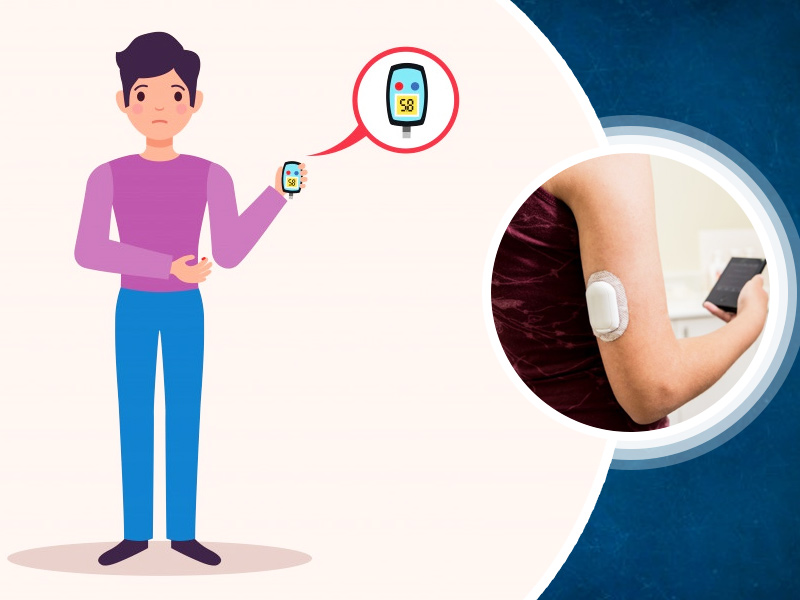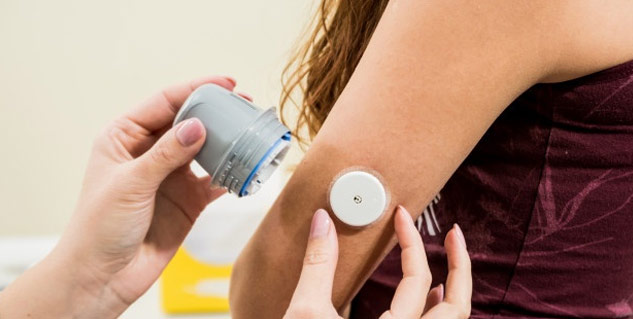
Managing diabetes is not easy as you need to be extra careful about your lifestyle. People with type-1 diabetes struggle with their blood sugar levels as they can get both high and low abruptly. Continuous glucose monitoring is a boon for such people as they can track their blood sugar levels at regular intervals. Some devices also come with alert system that alert you when the levels fluctuate. A lot of diabetics are not familiar with CGM and so, we reached out to Dr. Mudit Sabharwal, Consultant Diabetologist and Head of Medical Affairs at BeatO to know more about continuous glucose monitoring and how it can help in diabetes management.
Table of Content:-
What is continuous glucose monitoring?
Continuous glucose monitoring or CGM is a tool which works through a tiny, sterile and water -resistant sensor usually inserted under the belly or arm which tracks an individual's glucose levels through the interstitial fluid (the glucose found in the fluid in between the cells). Sugar levels are monitored throughout the day and night and at regular intervals, 24 hours a day.
The glucose readings which are tracked, are translated into dynamic data, generating glucose direction and rate of change in reports. These reports show real time glucose insights including glycemic trends, hyperglycemia, hypoglycemia and glucose variability. It helps in better diabetes management. Hence CGM is recommended in diabetic patients suffering with frequent hypoglycemia or hypoglycemia unawareness, frequent blood glucose fluctuations or those on intensive insulin therapy or intensive glucose control.
- The Time in Range derived from a CGM represents the percentage of time that a person with diabetes spends within their Target Glucose Range, or above or below that target.
- The Advanced Diabetes Technology and Therapeutics 2019 consensus recommendation for CGM was endorsed by American Diabetes Association 2019.
- “Time in Range” as a metric of glycemic control that provides more actionable information than HbA1c alone. The Metric includes three key CGM measurements: reading and time per day within the target glucose range (TIR), time below target glucose range (TBR), and time below target glucose range (TAR). 2019 consensus.
- Under normal circumstances a person having diabetes should spend at least 70% (around 17 hours) of the day in the range, 70–180 mg/dL, less than 4% (around 1 hour) of the day below 70 mg/dL, minimize time each day above 180 mg/dL.

Also Read: What Is HbA1c Test for Diabetes And Why It Is Done?
As per various studies published every 10% increase in TIR = ~0.5% (5.5mmol/mol) A1c reduction in T1D; and =~0.8% (8.7mmol/mol) A1c reduction in T1D and T2D. Also as per IMPACT study the risk of microvascular complications is inversely correlated with % TIR where every 10% lower TIR, retinopathy increased by 64% and microalbuminuria increased by 40%.
How continuous glucose monitoring can aid diabetes control?
“We have been using Continuous Glucose Monitoring systems in addition to the Self-Monitoring of Blood Glucose (SMBG) for diabetes coaching and control in thousands of our patients,” says Dr. Mudit. CGM clearly complements SMBG and works as an excellent tool in personalising corrections in an individual's diet, exercise and lifestyle and even medication as per the respective glucose variations caused by them. It helps in controlling the patient’s blood glucose levels more effectively.
As per recent data published and presented by Dr Mudit in American Diabetes Association 2020 where CGM was used as a tool in managing diabetes in 214 patients, it was observed to improve the average eA1C by 0.6 units (6.9% to 6.3%).

Also as per recent data published by Dr Mudit in the Endocrine Practice journal in 2020, where a comprehensive retrospective analysis of glycemic variability was assessed using CGM in diabetic patients with and without microvascular complications. The study provided a detailed understanding of patterns of glycemic variations in diabetes patients (with and without microvascular complications), with more glycemic variability observed in those with microvascular complications.
Also Read: Low-Glycemic Vegetables To Keep Your Shooting Sugar Levels In Control
As per the data by an AI-enabled digital care platform that enables users to control, manage and reverse Diabetes, when diabetes coaching was done using CGM along with Self-Monitoring of Blood Glucose through connected glucose monitoring devices, there was an approximate 25% increase in Target in Range glucose values and a better eA1C reduction in patients with uncontrolled diabetes.
Conclusion
Therefore, Continuous Glucose Monitoring along with the Self-Monitoring of Blood glucose in a connected care ecosystem, it may also help in reduction of overall glycemic levels, HBA1C levels, glycemic variability, prevention of microvascular complications, preventing and controlling hypoglycemia and improvement in quality of life in patients with diabetes.
Image credits- freepik
Also watch this video
How we keep this article up to date:
We work with experts and keep a close eye on the latest in health and wellness. Whenever there is a new research or helpful information, we update our articles with accurate and useful advice.
Current Version